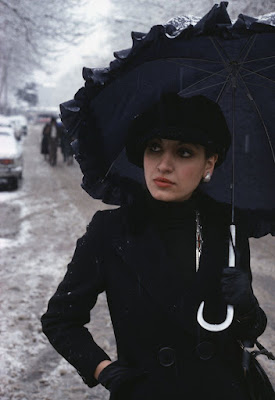Iran before Ayatollah Khomeini
Walking down a snowy street in Tehran in 1976: "You cannot stop women walking in the streets of Iran, but you wouldn't see this today - her earrings and make up so clearly on show," Prof Afshar says. "There is this concept of 'decency' in Iran - so nowadays women walking in the streets are likely to wear a coat down to her knees and a scarf."
- In the decades [1941-1979] prior to the Islamic Revolution of 1979, Iran was ruled by the Shah-King Mohammad Reza Pahlavi

from: Max Style catalogue
- Shah's dictatorship repressed dissent and restricted political freedoms
- Under Shah's rule, Iran's economy and educational opportunities expanded
- Britain and the U.S counted Iran as their major ally in the Middle East
from:Iranian women - before and after the Islamic Revolution - BBC News
Watch: https://youtu.be/T4M_EJzjItk
from: Iranian Historical and Information Center
- Due to Iran's supply of oil, proximity to India and shared border with the Soviet Union, Britain and the U.S fully backed the Iranian government
- Communists and religious members of society disliked the Shah and his pro-Western government
Friday picnic in Tehran in 1976: Families and friends tend to get together on Fridays, which are weekend days in Iran. "Picnics are an important part of Iranian culture and are very popular amongst the middle classes. This has not changed since the revolution. The difference is, nowadays, men and women sitting together are much more self-aware and show more restraint in their interactions," says Prof Afshar.
- In 1953, the Shah fled Iran after a Western-backed coup to overthrow Iranian Prime Minister, Mohammad Mosaddegh failed
- A second coupr succeeded in overthrowing Mosaddegh who wanted to nationalise the Iranian oil industry to Britain's chagrin
- The Shah returned to the country
- Like Ataturk in Turkey, Reza Shah undertook a series of reforms aimed at turning Iran into a modern westernized nation
- These reforms included the structuring of Iran around a Persian identity
- Women were banned from wearing veils in public, as part of Reza Shah's strategy to make religious observation subservient to the state
- Women were also encouraged to attend school
- Shah's intentions to westernize Iran alienated and frustrated religious conservatives and traditionalists
- Despite conservative backlash, the Shah managed to create a seemingly cosmopolitan city life
from: Boredpanda
- Toward the end of the Shah's reign, the royal family attempted to rally the country around an increasingly historic nationalism on the preceding Persian empires
from: Vintag.es
- In 1967, the Shah took the old Persian title "Shahanshah", or King of Kings at a coronation ceremony in Tehran
from: Vintag.es
- Tehran funded study abroad in Europe for Iranians. Schools and clinics were built throughout the Iranian countryside to care for poorer children as part of the Shah's White Revolution, an American-inspired package of measures designed to give the regime a liberal and progressive facade
- Ayatollah Khomeini denounced the Shah's programs, issuing a manifesto that bore the signatures of eight other senior scholars, listing the various ways the Shah had violated the Constitution
Ayatollah Khomeini, the leader and the founder of Iran's 1979 Islamic revolution during a press conference. Tehran-Iran, 05/02/1979
from: Alfred Yaghobzadeh Photography | Ayatollah Khomeini, the leader of Iran's 1979 Islamic revolution.
- By January 1979, Reza Shah fled Iran during the Iranian revolution
The Revolution was sparked by outrage against governemtn extravagance, corruption, brutality, and the suppression of individual rights before being taken over by Ayatollah Khomeini
Pro-hijab rally in Tehran in 2006: More than 25 years after the revolution, women backing the hardliners in the establishment staged their own rallies to protest against what they saw as the authorities' failure to enforce the compulsory hijab law. Here, the women are all dressed in black chadors with the exception of a little girl.
Information from:
- Historic Personalities of Iran: Ayatollah Khomeini (iranchamber.com)
- Photos Show Iran Before the 1979 Islamic Revolution (businessinsider.com)
- Alfred Yaghobzadeh Photography | Ayatollah Khomeini, the leader of Iran's 1979 Islamic revolution.
- Before the Islamic Revolution: 21 Vintage Photos Capture Everyday Life in Tehran, Iran From the 1960s and 1970s ~ Vintage Everyday
- Step Feed













Comments
Post a Comment